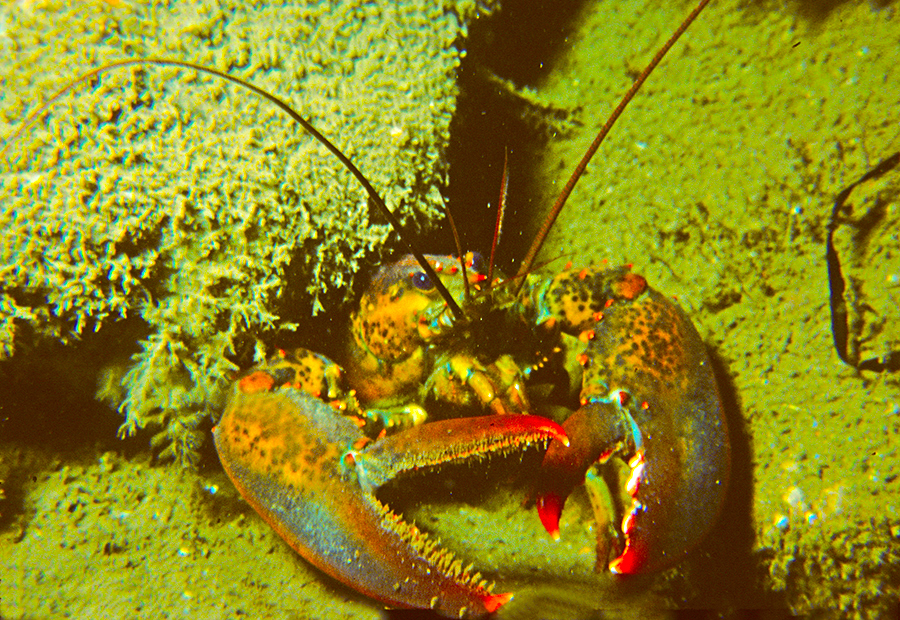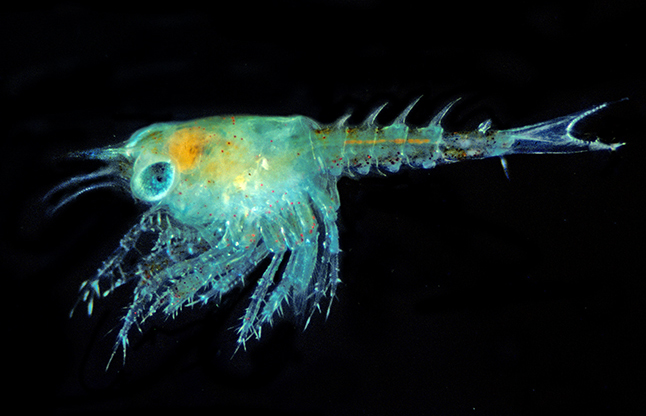The first European settlers to reach the shores of Massachusetts often found piles of lobsters stranded on the beach. Then regarded as “cockroaches of the sea,” they were used as bait and fertilizers, and eventually fed to servants, prisoners and slaves. But by the late 1700s, colonists had already begun to develop a taste for the creatures. Lobstering ultimately began in the coastal shallows of Cape Cod and around 1810, in Long Island Sound. By 1840, increasing demands for the tasty crustacean in Boston and New York encouraged some fishermen to spend more time lobstering. Working from a small boat, it has been said that they could spear as many as 150 lobsters in a single morning!

American lobsters, widely regarded as some of the most delectable creatures harvested from the sea, range from Labrador to North Carolina. Close to shore, small juveniles can be found under intertidal rocks, especially during a very low spring tide. Larger juveniles and adults inhabit waters from below the low tide line to an offshore depth of about 2,300 feet. At that depth, most are found along the continental shelf, near underwater canyons. Off New England and the Hudson Canyon, they can be found occupying hard-clay burrows, believed to have been first formed by tilefish. Positioned close together, they resemble Pueblo Villages. In late spring and summer, some of the offshore lobsters migrate to near-shore waters to spawn. However, Long Island Sound’s lobsters do not migrate.
Near the coast, lobsters burrow under rocks, wreck debris or mud bottoms. Protecting themselves from predators, they remain in their shelter during daylight hours and emerge after dark to hunt for their prey such as small fish, sea stars, crabs, clams, snails and marine worms. About one third of their diet depends on scavenging.
As a lobster grows, it sheds (molts) its old shell. However, before doing so, the lobster prepares itself by remaining in the safety of its burrow. Lying on its side, it flexes itself back and forth and eventually backs out of its old shell. The process can take a few minutes to about a half hour. Once free, it often is said to resemble a “black rubber toy.” Remaining in its burrow for one or more weeks, the crustacean absorbs water, making it swell to a larger size. By the time that the lobster has reached a weight of about a pound at 5 to 7 years of age, it may have shed its shell up to 25 times. During their first season, young lobsters molt five or six times. As adults, they may do so only once or twice per year. Lobsters inhabiting very cold waters, molt less often than those in warmer water.
During molting, the crustaceans can also replace a lost limb, eyes and antennae. With each molt, the lost part progressively grows to resemble the lost part.

Mating generally occurs right after a mature female sheds her shell, with her new shell still soft. A 1-pound female produces about 8,000 eggs while a 9-pound individual can produce 100,000 eggs. Carried under their tail, the eggs hatch into planktonic larvae that go through four different stages before heading to the bottom. However, relatively few of the larvae survive. Of every 50,000 eggs, only two of them can be expected to make it to adulthood!
American lobsters, especially those occupying colder water, can have a very long life span. A few can live up to 100 years. Caribbean spiny lobsters seldom, if ever, live even up to 20 years. The majority of our lobsters are dark in color but one out of every two million can be blue. Even more rare are those sporting a yellow shell or even a white one.
In 1926, a lobster caught in Maine was described as 33-inches long, weighing 51.5 pounds. The claim however, was never substantiated. A 44 pounder, caught off Nova Scotia in 1977, made the official Guiness World Record. Three years earlier, another nicknamed “Big George” was taken off the coast of Cape Cod, weighing in at 34 pounds.
By far, Maine has been the leading producer of American lobsters, with Massachusetts the second. Together, they account for 93 percent of the Nation’s total harvest. Along New Hampshire very short coast, lobsters account for 90 percent of all its commercial species. In 2022, Maine’s lobster landings were valued at $388,589,931, earning more than all of the state’s other fisheries.
Lobstering in Long Island Sound was once a thriving activity. Twenty-five years ago, Connecticut lobstermen landed some 3.7 million pounds of the crustaceans. About one half as many were successfully harvested out of the Sound’s New York waters. However, by 2018-2019, there was a 97 percent drop in Connecticut landings. As a result, most of the Sound’s lobstermen gave up the business. Lobstering in Maine continues to be a major fishery.
Lobsters are a cold-water species. They reach their stress level in waters of over 68 degrees Fahrenheit. With the increasing Global temperatures, the Sound has followed suit with bottom water temperatures rising faster than that of the surface waters. As a result of being non-migratory, warmer waters are believed to have directly contributed to the loss of thousands of western Sound lobsters. The crustaceans are also undergoing losses at the eastern end of Long Island Sound. Prolonged exposure to warmer waters, has also caused death from a parasitic disease. In its eastern waters, an estimated 50 percent of the crustaceans have been infected by a shell disease. The disease has also infected lobsters in coastal Rhode Island and Massachusetts. Appearing as deep circular lesions on the top of their shell, it sometimes spreads over a lobster’s entire body. Other bacterial infections can also infect these crustaceans.
In 1984, the Connecticut DEEP Marine Fisheries initiated otter trawl surveys of Long Island Sound, from Greenwich to New London, Connecticut. Using a 46-foot otter trawl net from the 50-foot R/V John Dempsey, the towing is conducted at depths of 16 to 150 feet, over mud, sand and mud/sand sediments. Before beginning a trawl, the water’s depth, salinity and temperature are measured. They then conduct a 30-minute trawl. When the net is brought up, they measure, weigh and count each species retrieved, such as finfish, lobsters and squid, before returning them to the water. During the entire survey period, they cover more than 40 sites, in Connecticut and New York State waters Along with the loss of lobsters, their findings revealed that species of fish in Long Island Sound that favor cooler temperatures are decreasing in numbers, while those that tolerate warmer water are increasing.
Traditionally, fishermen have used traps to harvest lobsters. As the fishermen abandoned lobstering, some left their wire-mesh traps behind, sitting on the bottom. Unfortunately, they now function as “ghost traps,” capturing crabs, lobsters, fish, and other marine life that venture in and eventually die of starvation when they can’t find their way back out. The dead species then serve as bait for others. It is estimated that up to about 1 million lobster traps lie at the bottom of Long Island Sound.
A 2022 Fiscal Year omnibus spending bill approved $569,000 for the removal of the hundreds of thousands of derelict lobster traps on the bottom of the Sound. A coalition, led by the Maritime Aquarium of Norwalk, are overseeing removal of the abandoned traps. Engaged in the process are lobstermen, fishermen, academics and environmentalist. As of June 1, 2023, Cornell Cooperative Extension of Suffolk County succeeded in removing 21,000 lobster traps from New York waters. Connecticut’s recovery program has just started. Initially, 365 traps were removed. However, a total of 95 recovery trips are planned for this summer and autumn.
Though greatly reduced, commercial lobstering continues at some sites in Long Island Sound. Recreational lobstering permits are required in New York and Connecticut waters. A New York resident is allowed to set no more than 5 lobster pots and take a maximum of 6 legal-size lobsters per day. They can only be taken for personal use and not for sale. Female lobsters bearing eggs must be immediately released. SCUBA divers in both waters must follow that state’s limits. Connecticut allows 10 lobster pots with the limit of 10 legal size lobsters per day. The legal length must be 3-3/8 carapace length with a maximum of 5 ¼ carapace length.
